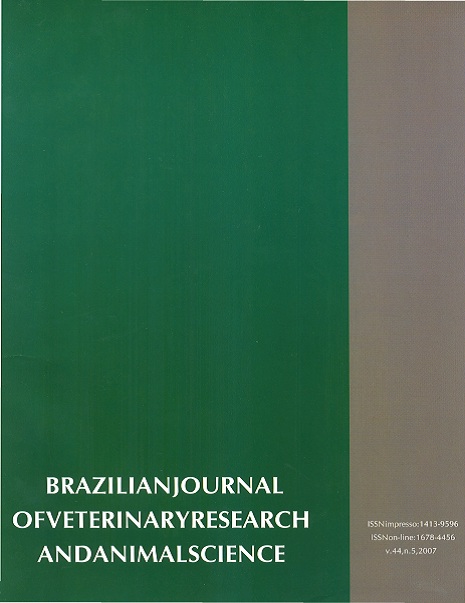Induced accumulative copper poisoning in catle
DOI:
https://doi.org/10.11606/issn.1678-4456.bjvras.2007.26620Keywords:
Copper, Bovine, LiverAbstract
The principal objective of this project was to evaluate clinical and hematological alterations and the hepatic concentration of Cu in cattle with accumulative copper poisoning, by infusion of increasing doses of copper. Ten cattle yearling steers were randomly distributed into a copper supplemented group (BOV Cu; n = 6) and one control group (BOV; n = 4). The group BOV Cu received initially 2 mg Cu/kg/BW (as CuSO4.5H2O) daily for one week; every following week, up to the end of the experiment (105th day), this initial dose was increased by 2 mg Cu/kg/BW. Three liver biopsies were realized during the experiment (day zero, 45th, and 105th day) to evaluate the degree of copper accumulation in this organ; the body weight and clinical examination was monitored every 15 days, when blood samples were taken. Three cattle supplemented with copper demonstrated clinical manifestations and/or laboratory findings consistent with accumulative copper poisoning (ACP), and died. Two distinct clinical manifestations were observed, one classical (n = 1) and another atypical (n = 2) characterized by remarkable high levels of liver copper, progressive hyporexia followed by anorexia, dehydration, severe apathy, decreased rumen movements, oliguria, and death. Some animals were resistant to ACP despite high accumulative levels of hepatic copper. Cattle with ACP increased their zinc liver concentration at the final stages of the poisoning. No poisoned animals developed renal insufficiency.Downloads
Downloads
Published
2007-10-01
Issue
Section
UNDEFINIED
License
The journal content is authorized under the Creative Commons BY-NC-SA license (summary of the license: https://
How to Cite
1.
Minervino AHH, Barrêto Júnior RA, Ferreira RNF, Saut JPE, Rodrigues FAML, Headley SA, et al. Induced accumulative copper poisoning in catle. Braz. J. Vet. Res. Anim. Sci. [Internet]. 2007 Oct. 1 [cited 2025 Apr. 18];44(5):364-72. Available from: https://revistas.usp.br/bjvras/article/view/26620





